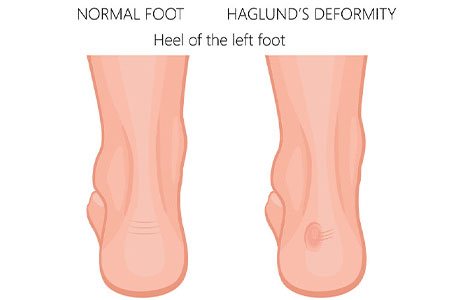Best Sandals for Kids with Haglund’s Deformity – Adjustable Straps and Extra Padding!
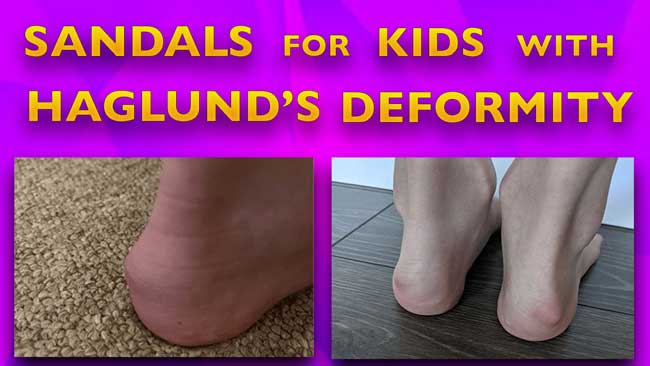
Have you noticed your child limping and complaining about heel pain? Has your medical professional diagnosed your child with Haglund’s deformity? This condition, characterized by a bony enlargement on the back of the heel, can cause significant discomfort and pain. One of the most effective ways to treat this condition is by wearing soft-backed shoes to help avoid or minimize irritation in the heel area.
Did you know that Haglund’s deformity is also called “pump bump”? This is because shoes with rigid backs apply extra friction and pressure which irritates the heel bone, causing the characteristic swelling and pain of the condition. For example, the sandal below has a rigid back made out of plastic which can further irritate the condition:
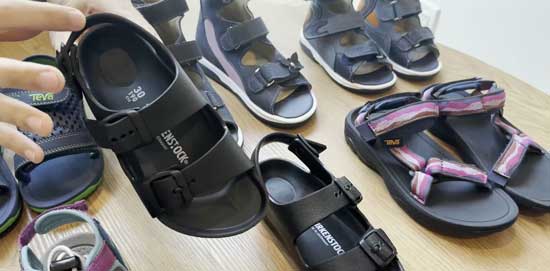
My Experience Helping Children with Haglund’s Deformity
Pediatricians and physical therapists often refer children to the specialized shoe store where I work for expert shoe fittings—and when needed, orthotic support. My first priority is to ensure the child isn’t wearing shoes with stiff heel counters, as these can worsen the condition by irritating the enlarged area on the heel.
What Causes Haglund’s Deformity in Children?
Medical experts believe the top three causes are:
- High arches
- Tight Achilles tendons
- Genetics
From my experience, children with high arches or those who supinate—walking more on the outer edge of their heels—are especially prone to developing this condition.
Images of Children with Haglund’s Deformity
Take a look at these images of children with Haglund’s deformity whom I’ve helped find the perfect, pain-relieving shoes.



Should Children Wear Shoes with Open Backs Such As Flip-Flops?
While many medical professionals recommend wearing shoes with open backs this is not possible for most children as the shoes need to provide them with a certain degree of support and stability.
Can you imagine walking around in flip-flops all day? Shoes with open backs can easily overtire your child’s feet and cause tendon problems. Your child’s toes will have to work extra hard to keep the shoes on, and this can cause stiffness and pain.
What Makes the Sandals I Recommend Effective for Haglund’s Deformity?
The sandals I recommend come with open backs but with adjustable and cushioned straps that will allow your child to adjust how much pressure to put around the heels.
Key Feature One: Extra Padding and Cushion Around the Heels. One of the most critical features to look for in sandals for kids with Haglund’s deformity is extra padding and cushioning around the heels. This padding helps to absorb shock and reduce pressure on the heel, providing much-needed relief. In addition to cushioning, the material used should be soft and breathable to prevent further irritation.


Key Feature Two: Adjustable Straps. Adjustable straps are another essential feature. This adjustability helps prevent the sandal from rubbing against the heel and causing irritation. Sandals with multiple adjustable points can offer a more precise fit, ensuring that the shoe stays securely in place during various activities.

When it comes to selecting sandals for kids with Haglund’s deformity, there are a few options available. These recommendations are based on customer reviews, expert insights, and the specific needs of children with this condition. Disclosure: We may earn commissions if you click our links and make a purchase.
Best Sandals for Kids with Haglund’s Deformity
Here are my top recommendations for 2025. Take a look at the description below each sandal to find out whether it can accommodate your child’s foot shape (medium, wide), and to find out what additional features each sandal provides.
1. Hurricane by Teva
The triple Velcro straps and extra cushion and padding around the heels make the Hurricane by Teva one of the best sandals for Haglund’s deformity.
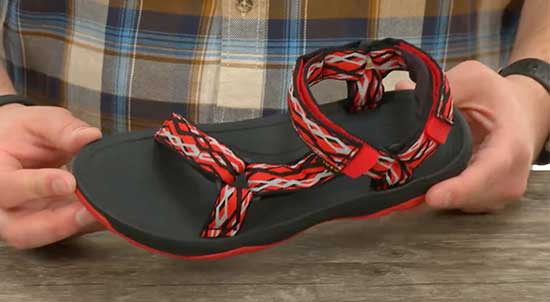
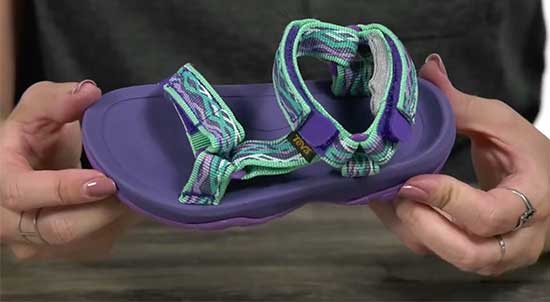
Key Features
- Order the sandal Hurricane by Teva on Zappos or Amazon
- Fits medium and wide feet
- This internal support mechanism is anatomically engineered to provide excellent support
- Machine washable
- I suggest that you get this sandal a half size larger than your child’s current foot size
2. Adventure Seeker by Timberland
This Timberland sandal is designed with extra padding and cushioning around the heels, making it ideal for children with Haglund’s deformity. This sandal provides a comfortable, supportive fit that helps reduce heel irritation while keeping active feet secure and protected.
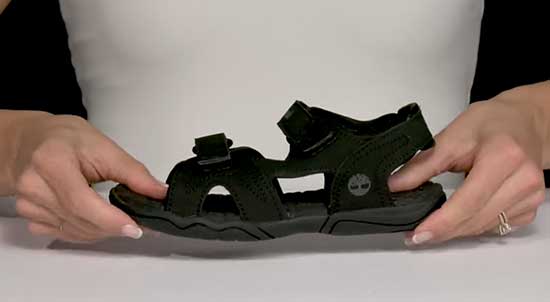
Key Features
- Order the sandal Adventure Seeker by Timberland on Amazon or Zappos
- Fits medium and wide feet
- Two adjustable straps with hook-and-loop closure
- Eva foam footbed cushions and softly supports for all day comfort
- I suggest that you get this sandal half a size larger than your child’s current foot size
3. Motozoa by Keen
This Keen sandal also features extra padding and cushioning around the heels, offering comfort and support for children with Haglund’s deformity. Its soft, protective fit helps reduce irritation.
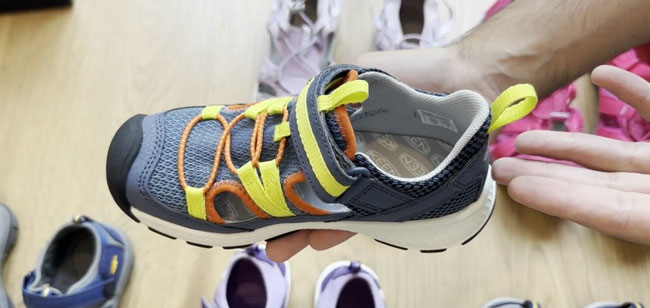
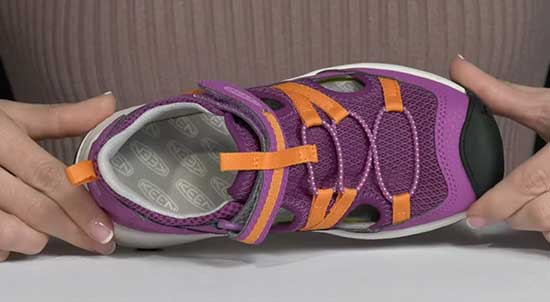
Key Features
- Order the sandal Motozoa by Keen on Amazon or Zappos
- Fits medium and wide feet
- Two adjustable velcro straps for easy on and off
- Extra padding around the straps
- I suggest that you get this sandal a whole size larger than your child’s current foot size
The Importance of Ordering the Correct Shoe Size
One of the most crucial aspects of managing Haglund’s deformity is ensuring that your child wears the correct shoe size. Ill-fitting shoes can aggravate the condition, leading to increased pain and discomfort. Shoes that are too tight can exert undue pressure on the heel, while those that are too loose can cause excessive movement and friction. If you want to be 100% sure about what shoe size to order online, I suggest that you take your child to your local specialized children’s shoe store or use a virtual shoe fitting resource I created.
Contact Me for Personalized Recommendations
If you’re unsure about which sandals are best suited for your child’s unique foot shape, feel free to contact me via email for personalized sandal recommendations. I’m here to help you find the perfect pair that will offer both comfort and support.
Watch My YouTube Video On Sandals for Haglund’s Deformity
For more insights and visual guidance, be sure to watch my YouTube video on selecting the best sandals for kids with Haglund’s deformity. In the video, I walk you through the top features to look for and showcase some of my top sandal picks.
What Are the Best Sneakers for Kids with Haglund’s Deformity?
Sneakers with features like cushioned insoles, padded heel counters, and flexible soles can help manage the symptoms of Haglund’s deformity effectively. For more information, check out my bonus resource on the best sneakers for kids with Haglund’s deformity.
If this condition doesn’t improve your doctor might require surgery, so please make sure that you take the necessary steps to prevent this condition from getting worse. Always prioritize the correct shoe size to avoid aggravating the condition, and steer clear of flip-flops and other inadequate footwear options that lack necessary support and protection.

